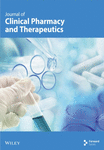Drug monitoring during the treatment of AIDS-associated Pneumocystis carinii pneumonia with trimethoprim-sulfamethoxazole
Abstract
Objective: To monitor trimethoprim and sulfamethoxazole plasma levels in patients with AIDS-associated Pneumocystis carinii pneumonia
Method: Trimethoprim–sulfamethoxazole steady-state plasma concentrations were measured by high-pressure liquid chromatography during 37 episodes of Pneumocystis carinii pneumonia in patients with AIDS. Initially, 15–23 mg/kg/day trimethoprim and 75–115 mg/kg/day sulfamethoxazole were given i.v. Assuming a therapeutic range for trimethoprim from 4 to 10 μg/ml, the doses were adjusted if trimethoprim levels were found to be outside this range
Results: Mean concentrations were 6·7±3·3 μg/ml for trimethoprim and 187±56 μg/ml for sulfamethoxazole. A widespread inter-patient range was found and could be decreased after dose adjustment. Enzyme inducing co-medication did not influence plasma concentrations. In patients with coexisting chronic liver disease, significantly increased sulfamethoxazole plasma levels were observed. A correlation could be demonstrated between serum creatinine and trimethoprim plasma levels. Adverse reactions associated with co-trimoxazole occurred during 65% of treatment periods and increased with increasing trimethoprim-sulfamethoxazole levels, as well as increasing length of treatment. Therapy only had to be prematurely discontinued in one patient. Overall mortality was 2·7%Conclusion: Monitoring of co-trimoxazole levels during the treatment of P. carinii pneumonia in AIDS may help in reducing the high variability of plasma-concentrations and in avoiding severe side-effects especially associated in patients with chronic liver disease or renal failure




